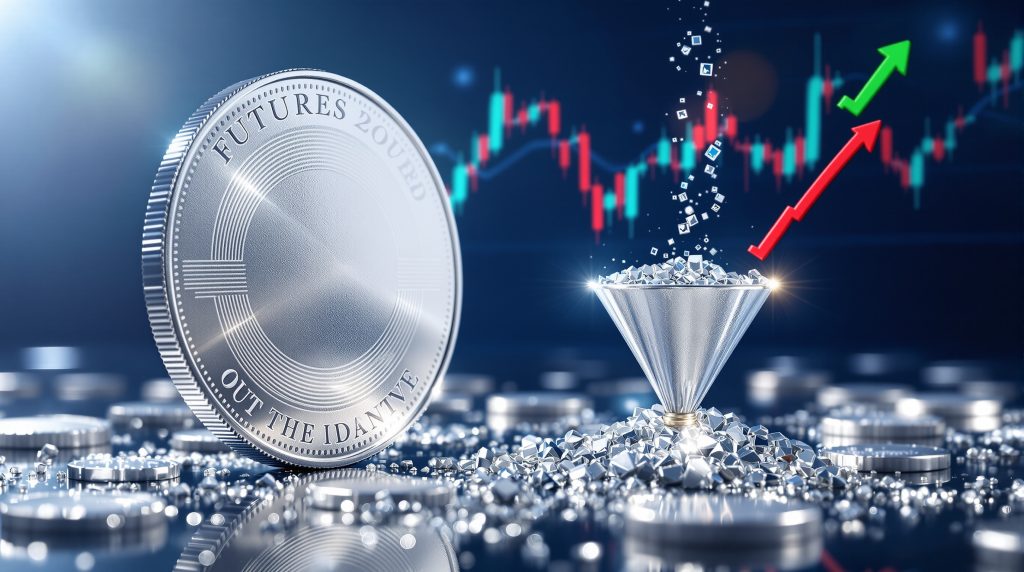Understanding Silver Backwardation: A Market Signal Worth Watching
Backwardation in the silver market occurs when spot prices exceed futures prices—reversing the normal market condition called contango. This unusual pricing structure signals immediate physical demand for silver that outstrips available supply. When traders prioritize immediate delivery over future delivery despite lower future prices, it reveals significant market stress and potential supply constraints.
This phenomenon serves as a critical indicator for precious metals analysis since it often precedes significant price movements and reflects fundamental supply-demand imbalances that paper markets struggle to resolve.
How Does Normal Silver Market Pricing Work?
Under typical market conditions, silver futures contracts trade at higher prices than spot silver. This normal state (contango) exists because futures prices incorporate carrying costs—storage, insurance, and financing expenses—that accumulate over time.
For example, in a normal market:
- Spot silver price: $30.00/oz
- 3-month futures price: $30.25/oz
- 6-month futures price: $30.50/oz
This pricing structure naturally reflects the time value of money and costs associated with holding physical silver. Contango represents the market's equilibrium state when supply and demand remain relatively balanced.
According to London Bullion Market Association (LBMA) guidance, physical silver storage costs typically average $0.50-$1.00 per ounce annually at recognized facilities, contributing to the normal contango spread of 0.5% to 2% annually.
When and Why Does Silver Backwardation Occur?
Backwardation emerges when immediate physical demand significantly outstrips available supply, creating a premium for immediate delivery. In backwardation:
- Spot silver price: $30.00/oz
- 3-month futures price: $29.75/oz
- 6-month futures price: $29.50/oz
Several factors can trigger this market inversion:
Physical Supply Constraints
- Mining disruptions or production shortfalls
- Refinery bottlenecks limiting finished product availability
- Logistical challenges affecting delivery networks
- Geopolitical events restricting normal supply flows
Heightened Physical Demand
- Institutional investors seeking physical allocation
- Retail investor surge for coins and small bars
- Industrial users securing inventory amid shortage concerns
- Central bank dynamics or sovereign wealth fund accumulation
Market Stress Indicators
- Rising lease rates for silver (cost to borrow physical metal)
- Widening spread between paper and physical prices
- Delivery delays at major exchanges or dealers
- Premium pricing for specific silver products
The World Gold Council research on precious metals market structure confirms that when lease rates rise significantly (above 1-2%), it signals increased borrowing costs for physical metal—a key precursor to backwardation conditions.
Historical Examples of Silver Backwardation
Silver backwardation has occurred during several notable periods, each providing insights into market dynamics:
The 2011 Silver Peak
When silver approached $49.82/oz on April 28, 2011 (intraday high), the market entered backwardation as physical demand surged. This represented a dramatic rise from approximately $18 in August 2010. Investors rushed to secure physical metal amid concerns about market manipulation and inflation, creating delivery bottlenecks and premium pricing for immediate delivery.
Physical coin and small bar premiums increased dramatically during this period, with some dealers charging $5-10 over spot for immediate delivery of American Silver Eagles, according to coin dealer reports from April-May 2011.
2020 COVID-19 Market Disruption
During March-April 2020, global supply chain disruptions created a disconnect between paper and physical silver markets. While COMEX futures prices initially fell, physical premiums soared as refineries closed and logistics networks faltered. Major Swiss refineries (including Valcambi, PAMP, and Argor-Heraeus) temporarily closed or reduced capacity, disrupting normal delivery channels between London and New York markets.
Physical silver premiums spiked to $4-8 over spot for retail products, while major mints (US Mint, Royal Canadian Mint, Perth Mint) reported unprecedented demand. The COMEX April 2020 silver contract traded at a premium to the May 2020 contract, indicating backwardation in the futures curve.
The 1979-1980 Hunt Brothers Episode
The 1979-1980 period saw silver reach $50 on January 21, 1980, driven by the Hunt Brothers' attempted corner of the silver market. This created extreme backwardation conditions as physical delivery demand overwhelmed supplies, serving as a textbook example of market manipulation leading to backwardation.
How Can Investors Interpret Backwardation Signals?
Backwardation provides valuable market intelligence for investors when properly understood:
Market Tension Indicator
When backwardation appears, it signals underlying tension between paper market pricing and physical reality. This disconnect often resolves through price adjustments rather than increased physical supply, particularly in the short term.
Potential Price Movement Precursor
Historically, persistent backwardation has preceded significant price movements as market forces eventually reconcile the pricing anomaly. While not guaranteeing immediate price increases, it highlights fundamental supply-demand imbalances that typically support higher prices.
Physical Ownership Premium
During backwardation, physical silver holders gain an advantage, as their metal commands a premium over paper contracts. This creates potential arbitrage opportunities for those with deliverable metal.
Market Stress Assessment
The degree and duration of backwardation provide insights into market stress levels. Brief, shallow backwardation may indicate temporary tightness, while deep, persistent backwardation suggests more fundamental supply issues.
CME Group EFP (Exchange for Physical) transaction data shows that during normal markets, EFP spreads typically range from $0.02-0.05 per ounce, but during stress periods can widen to $0.10-0.50+ per ounce. In extreme episodes like 2020, these spreads exceeded $1.00 per ounce.
How Backwardation Affects Different Market Participants
The impact of silver backwardation varies across different market participants:
Physical Silver Investors
Holders of physical silver benefit during backwardation as their assets command premium pricing. This validates the "insurance" aspect of physical ownership and potentially creates profitable selling opportunities.
Futures Market Traders
Traders face increased volatility and delivery risk during backwardation. The normal cost-of-carry model breaks down, creating both risks and opportunities for sophisticated market participants.
Industrial Silver Users
Manufacturing companies that require silver as an input face higher immediate costs and potential supply uncertainties. This often leads to inventory building and long-term supply contract negotiations.
Mining Companies
Silver producers may benefit from premium spot pricing while potentially facing pressure to deliver into existing hedge positions at lower prices. The opportunity to sell production at spot rather than forward prices becomes attractive.
During backwardation periods, mining companies with unhedged production gain significant advantages. For example, during recent precious metals bull markets, major producers like Newmont have reported substantial free cash flow increases—from $1.5 billion in Q1 to $1.7 billion in Q2 in a recent reporting cycle, according to the market data.
How to Monitor Silver Backwardation
Investors can track several indicators to identify and measure backwardation:
Key Metrics to Watch
- Spot-to-futures spread: The price difference between immediate delivery and future delivery contracts
- Silver lease rates: The cost of borrowing physical silver, which rises during supply tightness
- EFP (Exchange for Physical) rates: The premium paid to exchange a futures contract for physical delivery
- Physical premiums: The markup over spot price for physical silver products
Information Sources
- Futures exchange data (COMEX, LBMA)
- Precious metals dealer premium reports
- Specialized market analysis from bullion banks
- Mining company production and delivery reports
Specific Monitoring Tools
- Futures Curve Analysis: Compare spot vs. 3-month, 6-month, and 12-month futures prices
- Warehouse Stock Tracking: Monitor COMEX-eligible warehouse inventory (published weekly by CME)
COMEX Silver Warehouse Stocks data shows weekly inventory figures of "eligible" vs. "registered" silver quantities available for delivery. In recent years, these typically range from 200-350 million ounces total, with fluctuations of 10-20% potentially signaling changing physical demand.
What Makes the Current Silver Market Unique?
Today's silver market presents distinct characteristics that influence backwardation dynamics:
Dual Demand Drivers
Unlike gold, silver faces both investment and industrial demand pressures. The metal's growing use in renewable energy, electronics, and medical applications creates baseline demand independent of investment flows.
According to The Silver Institute's World Silver Survey 2024, industrial applications represent approximately 50% of total annual demand, including:
- Photovoltaic (solar panel) production: ~130-150 million ounces annually
- Electronics and electrical applications: ~230-250 million ounces
Structural Supply Constraints
Approximately 72% of silver production comes as a byproduct of mining other metals (copper, lead, zinc, gold), with primary silver mines accounting for only 28% of global supply. This means silver supply doesn't always respond directly to silver prices, creating potential for sustained supply-demand imbalances.
Physical vs. Paper Market Size Disparity
The paper trading volume of silver dwarfs physical production by orders of magnitude. When physical demand surges, this disparity can create delivery stresses and pricing anomalies like backwardation.
Strategic Considerations for Investors During Backwardation
Investors can apply several strategies when silver enters backwardation:
Portfolio Positioning
- Consider increasing physical allocation during early backwardation signals
- Evaluate mining companies with unhedged production that benefits from spot premiums
- Monitor industrial silver users who may face margin pressure from higher input costs
Risk Management
- Recognize that backwardation, while significant, doesn't guarantee immediate price increases
- Understand that market normalization can occur through price increases OR futures price adjustments
- Consider diversification across different forms of silver exposure (physical, mining shares, ETFs)
Opportunity Assessment
- Evaluate potential arbitrage opportunities if you have deliverable physical metal
- Consider strategic accumulation during price corrections that occur despite backwardation
- Monitor for potential silver crash recovery scenarios that could extend or deepen backwardation
A balanced investment approach during backwardation typically involves maintaining core positions while strategically taking partial profits on significant price advances. As experienced market analysts advise, "you should hold on to your core positions, but trim positions on the way up" to manage potential volatility.
Backwardation as a Market Intelligence Tool
Silver backwardation represents more than just a pricing anomaly—it provides valuable market intelligence about physical supply-demand dynamics that paper markets cannot easily mask. While not a guaranteed price prediction tool, backwardation signals fundamental stress in the silver market squeeze that typically resolves through price adjustment.
For investors, understanding backwardation adds another analytical dimension beyond simple price charts. It reveals the underlying physical market reality and potential pressure points that may drive future price movements.
The significance of backwardation becomes particularly noteworthy in context of larger technical patterns. Silver's recent breakout from what market technicians describe as a "45-year cup and handle pattern" combined with backwardation and physical tightness creates a potentially explosive setup for price discovery, according to recent analysis from Bank of America.
As with any market indicator, backwardation is most valuable when considered alongside other fundamental and technical factors. However, its relative rarity and connection to physical market dynamics make it particularly noteworthy when it appears in the silver market. Understanding the mechanics of normal backwardation is essential for investors seeking to interpret these market signals correctly.
Disclaimer
This article is for educational purposes only and does not constitute financial advice. Silver markets involve risk, and past performance is not indicative of future results. Always conduct your own research and consider consulting a financial advisor before making investment decisions.
Want Real-Time Alerts on Major ASX Mineral Discoveries?
Discover why significant mineral discoveries like the silver market developments discussed in this article can lead to substantial investment returns by exploring Discovery Alert's dedicated discoveries page, where the proprietary Discovery IQ model transforms complex market data into actionable investment insights.




